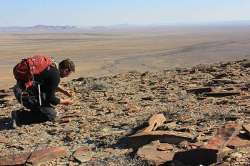Early animals may have caused first mass extinction, say researchers
In a new study, researchers, it has been discovered that new fossil found in southeast African country of Namibia reinforces the theory suggesting that the world’s first mass extinction was caused due to the planet's

In a new study, researchers, it has been discovered that new fossil found in southeast African country of Namibia reinforces the theory suggesting that the world’s first mass extinction was caused due to the planet's earliest animals, known as metazoans.
The event, the end-Ediacaran extinction, took place 540 million years ago. The earliest life on Earth consisted of microbes - various types of single-celled organisms, said researchers from Vanderbilt University in the US.
These held sway for more than 3 billion years, when the first multicellular organisms evolved. The most successful of these were the Ediacarans, which spread around the globe about 600 million years ago, they said.
They were a largely immobile form of marine life shaped like discs and tubes, fronds and quilted mattresses.
After 60 million years, evolution gave birth to another major innovation: metazoans, the first animals. Metazoans could move spontaneously and independently at least during some point in their life cycle and sustain themselves by eating other organisms or what other organisms produce.
Animals burst onto the scene in a frenzy of diversification that paleontologists have labeled the Cambrian explosion, a 25 million-year period when most of the modern animal families - vertebrates, mollusks, arthropods, annelids, sponges and jellyfish - came into being, researchers said.
“These new species were ‘ecological engineers’ who changed the environment in ways that made it more and more difficult for the Ediacarans to survive,” said Simon Darroch from Vanderbilt University.
Researchers have found one of the best-preserved examples of a mixed community of Ediacarans and animals, which provides the best evidence of a close ecological association between the two groups.
”Until this, the evidence for an overlapping ecological association between metazoans and soft-bodied Ediacaran organisms was limited,” said Darroch.
“Here, we describe new fossil localities from southern Namibia that preserve soft-bodied Ediacara biota, enigmatic tubular organisms thought to represent metazoans and vertically oriented metazoan trace fossils,” he said.
Although the precise identity of the tracemakers remains elusive, the structures bear several striking similarities with a cone-shaped organism called Conichnus that has been found in the Cambrian period, researchers said.
They discovered some new fossil sites that preserve both Ediacara biota and animal fossils (both animal burrows - ‘trace fossils’ - and the remains of animals themselves) sharing the same communities, which lets us speculate about how these two very different groups of organisms interacted.
“There is a powerful analogy between the Earth’s first mass extinction and what is happening today. The end-Ediacaran extinction shows that the evolution of new behaviours can fundamentally change the entire planet, and today we humans are the most powerful ‘ecosystems engineers’ ever known,” said Darroch.
The findings were published in the journal Palaeogeography, Palaeoclimatology, Palaeoecology.
(With inputs from PTI)